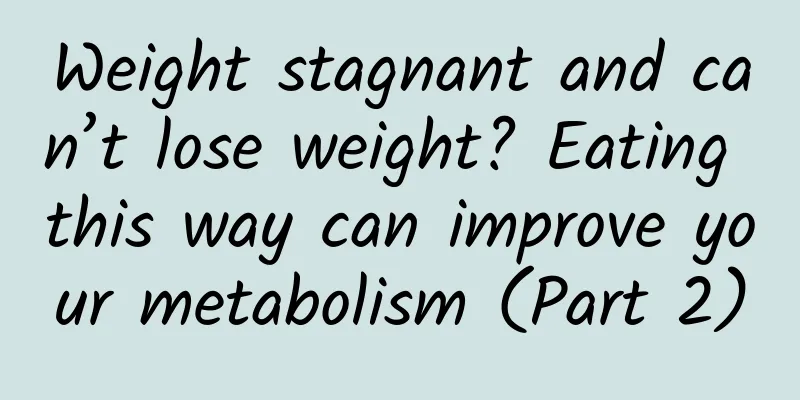Weight stagnant and can’t lose weight? Eating this way can improve your metabolism (Part 2)

|
Basically, from the beginning of weight loss to the process of losing weight to reaching the target weight, we may have multiple opportunities to encounter the phenomenon of weight maintenance. But not every time when your weight does not continue to decrease is called a "weight plateau". 1. If your weight is maintained at around a certain number of kilograms, but there are fluctuations in it (sometimes you lose weight and sometimes you gain weight), then there is something wrong with your diet and lifestyle. Just find out the reason and you can continue to lose weight. 2. If your weight has been maintained at a certain number of kilograms and is the same weight every day without much fluctuation, it may be a period of weight stagnation. This may be "mental stagnation" or "physiological stagnation". It is recommended to filter out whether it is mental stagnation first, because, based on the nutritionist's many years of one-on-one consultation experience, mental stagnation is often the main cause of weight stagnation. 3. Your weight is maintained at a certain number of kilograms, but after re-examining your food and mentality, you find that your mentality and diet have not relaxed, then it may be "physiological stagnation", which is the "real weight stagnation phenomenon." Physiological stagnation (or weight stability) may be temporary (temporary weight stagnation during weight loss) or long-term (such as when there is no deliberate weight loss, the weight naturally remains at a certain kilogram). Under normal circumstances, even if you are serious about losing weight, you may experience more than one "temporary" weight stability/adaptation phenomenon during the entire process (such as losing 20 kg). This is because during the weight loss process, the body continues to adapt to the low-calorie diet. In most cases, if you can persist and continue to implement it seriously, this temporary weight stagnation will pass after a period of time, until the intake and expenditure are just balanced (intake = expenditure à weight maintenance), at which time you will enter a "long-term" weight stagnation. For example, if your metabolism is 1800 calories, and you only eat 1200 calories in order to lose weight, in the beginning, you will lose weight faster because you eat 600 calories less per day. But after losing 3 to 5 kilograms, your body will adapt to eating less, and the impact of weight loss on metabolism and body composition will reduce your metabolism and may cause "temporary weight stagnation." But if you always stick to the 1,200-calorie diet and pay more attention to the food you eat, your weight will eventually continue to decrease (because there is still an energy gap, it's just smaller, and you have to calculate it rigorously, otherwise you won't lose weight if you accidentally eat too much). This process may be repeated several times (because there will inevitably be additional problems that affect the speed of weight loss during the weight loss process) until your metabolism is finally reduced to exactly equal to the consumption of 1,200 calories. At this point, if you still eat 1,200 calories of food, your weight will not decrease (because "intake = consumption"). At this point, you have two choices: 1. Stop losing weight and enter the maintenance period; 2. Eat less or do more exercise to increase the energy gap. 2. How to solve the problem of weight stagnation? Since the speed of weight loss depends on the energy deficit (the relationship between intake and expenditure), the best way to solve the problem of weight stagnation is to maintain a "high metabolism" (allowing the body to have a higher consumption) during the weight loss process, rather than simply eating less. This is because, eating less for a short period of time may be possible, but the gap between intake and expenditure will eventually narrow due to reduced metabolism, making weight loss slower and slower, until the weight can no longer be lost. The body's adaptation to a low-calorie diet Reduce physiological energy expenditure (thriftiness), increase energy intake (increase desire for food) & calorie absorption efficiency. 1. Balanced nutrition, appropriate intake of starchy foods and foods with higher nutritional quality at each meal to provide sufficient blood sugar and vitamins to reduce the lack of movement due to fatigue or discomfort, and reduce the frequency of hunger caused by hypoglycemia. 2. Eat three meals at regular times and in regular amounts, and balance the calories in each meal to avoid fasting for too long and absorbing calories too quickly. Reduced basal metabolism Basal metabolism accounts for 70% of metabolism, and lowering it will significantly reduce energy consumption. The reason for the decrease in basal metabolism is the malnutrition and loss of lean tissue caused by a low-calorie diet. 1. Use a nutritionally balanced weight loss method to reduce the impact of malnutrition on active metabolic tissues such as internal organs and muscles. 2. Eat more high-quality protein (containing branched-chain amino acids) to retain lean tissue and reduce metabolic loss. Reduced physical activity When you lose weight, you burn fewer calories engaging in physical activity. Increase the quality or quantity of physical activity to compensate for the decreased metabolism caused by weight loss. Simply put, it means increasing activity and exercise time. If there is no way to increase activity time, you can choose exercise with a higher unit intensity (exercise that can consume more calories). Reduced thermogenic effect of food intake When you eat less, the total amount of food is reduced, and the calories consumed related to food intake are relatively reduced. Eat more raw, unrefined foods to increase the amount of calories your body uses to break down food. You will find that the best way to prevent weight stagnation, keep losing weight smoothly, and avoid weight gain is to adopt the right weight loss method when you start losing weight. A balanced nutrition approach with three meals as the main meal and including rice, meat and vegetables + proper exercise. Although this is very cliché, it is “cliché” and “the kingly way” precisely because it is the truth, isn’t it? Perhaps, for those who want to lose weight quickly, this "correct way to lose weight" is a bit slow, but you must clearly understand that even if the weight loss speed is fast, it is useless if it cannot be sustained and the goal cannot be achieved (from a result-oriented perspective); furthermore, everyone who wants to lose weight must recognize one thing, losing weight is short-term, but maintaining weight is a lifelong process. Even if you have the perseverance to endure an inhuman life for a few months and lose weight, what happens after that? Can you use this method for the rest of your life to prevent it from gaining weight again? Therefore, in the long run, it is better to find a healthy weight loss method that suits you and is part of your daily life. This is why as a nutritionist, I spend so much time promoting the "correct concept of weight loss"! This article comes from: Nutritionist Stella's Weight Loss & Nutrition Blog ※For more information, please see "Nutritionist Stella's Weight Loss & Nutrition Blog" |
>>: How to eat to replenish nutrition after exercise? Soy milk + banana for bowel health
Recommend
What are the diagnostic criteria for pelvic peritonitis?
A disease that is easily induced by female friend...
How to treat adnexitis cyst
Treatments for adnexitis cysts mainly include ant...
What causes vaginitis?
What is vaginitis? What are the causes of vaginit...
What is delayed menstruation and early menstruation? Which is more terrible?
The female menstrual cycle is about 28 to 30 days...
What is ovarian cyst puncture and can it be cured?
What is ovarian cyst puncture? Can it be cured? 1...
In life, we must continue to do a good job in preventing cervical erosion
Cervical erosion is a common disease among women,...
What to do if you have premature ovarian failure
The ovaries are the reproductive organs of women ...
Does a woman's endometrial thickening mean she is pregnant?
During early pregnancy, due to the influence of e...
Effects of pelvic peritonitis on children
Female friends all know the harmfulness of pelvic...
TCM Diagnosis of Threatened Abortion
Chinese medicine is extensive and profound. Chine...
Explosive cream experience! After 6 years, Chinese hairy crabs are imported
The explosive cream experience is reproduced agai...
Will having Bartholinitis in a 6-month pregnancy affect fertility?
Bartholinitis is an inflammation caused by infect...
What should I do if my face turns yellow after an abortion? A few things to pay attention to after an abortion
It is quite common for the face to turn yellow af...
What are the dangers of pelvic inflammatory disease?
Pelvic inflammatory disease is a gynecological di...
Body dampness and heat affect abnormal vaginal discharge
Excessive dampness and heat in the body may indee...









